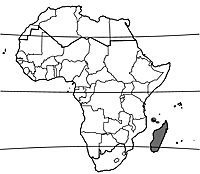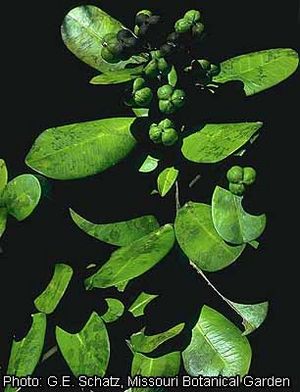Anthostema madagascariense (PROTA)
Introduction |
| General importance | |
| Geographic coverage Africa | |
| Geographic coverage World | |
| Essential oil / exudate | |
| Medicinal | |
| Timber | |
Anthostema madagascariense Baill.
- Protologue: Étude Euphorb.: 59–60, 544, t. 5(4–7) (1858).
- Family: Euphorbiaceae
Origin and geographic distribution
Anthostema madagascariense occurs in Comoros, Mayotte and eastern Madagascar.
Uses
The wood, called ‘mandravoky’ in Madagascar, is not durable and is used only when a wood is needed that is easily worked with hand tools to make small utensils. Because of its ample availability, it may be a suitable substitute for poplar and is probably suitable for light carpentry, boxes, crates, rotary veneer, and as a component in blockboard and fibre board.
The latex is used as glue. In traditional medicine a piece of sugarcane dipped into the latex of Anthostema madagascariense is sucked as a very strong purgative. Smoke from the wood is reportedly used to drive away animals.
Properties
The heartwood is white when freshly cut, turning pinkish beige upon exposure, and indistinctly demarcated from the sapwood. The texture is fine and even.
The wood is medium-weight, with a density of 520–610 kg/m³ at 12% moisture content. It is easy to dry with only little deformation. The rates of shrinkage are moderate, from green to oven dry 3.1–6.2% radial and 6.7–8.0% tangential. Boards of 2.5 cm thick take 2–3 months to air dry. After drying, the wood is stable in service. At 12% moisture content, the modulus of rupture is 121–138 N/mm², modulus of elasticity 9400–11,280 N/mm², compression parallel to grain 47–54 N/mm², cleavage 10–17 N/mm and Chalais-Meudon side hardness 1.6–2.4.
The wood is extremely abrasive in sawing and should be sawn before drying with a coarsely toothed, slow-moving blade and with a high transition speed. In addition the latex sticks to the blade, requiring continuous watering. The wood is very difficult to work. It is easy to nail; it holds nails and screws well. It is easy to glue, paint, varnish and wax. It may be suitable for veneer production by peeling if its abrasiveness does not prove to be excessive. The wood is not durable, with little resistance against fungi and insects, and requires preservative treatment at all stages of processing. It is very easy to impregnate with preservatives. The latex may cause eye problems. The seeds are toxic.
Description
- Evergreen, monoecious shrub to medium-sized tree up to 30 m tall, with abundant white latex in all parts; bole branchless for up to 12 m or more, generally straight and regular, up to 70 cm in diameter; bark surface densely fissured, reddish to blackish.
- Leaves alternate, simple and entire; stipules small, soon falling; petiole up to 1.5 cm long, grooved; blade elliptical to obovate, 5–13 cm × 2.5–5 cm, cuneate at base, acuminate to obtuse at apex, leathery, glabrous, pinnately veined with 10–15 pairs of lateral veins.
- Inflorescence an axillary cyme with at apex of each cyme-branch a common involucre composed of 4 small partly fused bracts with glandular margins, enclosing a female flower surrounded by involucres, each containing several male flowers.
- Flowers unisexual; male flowers with short pedicel, 3–4-toothed perianth and a single stamen; female flowers short, stout pedicel, 3–4-lobed perianth, ovary superior, glabrous, 3-celled, styles short, spreading.
- Fruit a deeply 3-lobed capsule c. 2 cm in diameter, green, turning brown at dehiscence, with persistent style, 3-seeded.
- Seeds ovoid, c. 12 mm long, laterally compressed, brownish, shiny.
Autres données botaniques
Anthostema is a small genus of 3 species, 2 in continental Africa and 1 in Madagascar. It is related to Dichostemma. The whitish wood of Anthostema senegalense A.Juss. is used in West Africa for local building purposes, poles for temporary fences, light carpentry work and boxes, but the primary use of this species is in local medicine (latex and bark).
Anthostema aubryanum
Anthostema aubryanum Baill. is a small to medium-sized tree up to 25 m tall with a bole branchless for up to 15 m and up to 50 cm in diameter, occurring from Côte d’Ivoire to Gabon and Congo. Its wood is similar to that of the other Anthostema spp. and undoubtedly used for similar purposes, and additionally as firewood. The latex is used as a drastic purgative, and is applied externally to sores. The bark is used as a fish poison.
Ecology
Anthostema madagascariense occurs in humid evergreen forest from sea-level up to 900(–1700) m altitude, sometimes in swamps. It is locally abundant below 500 m altitude.
Management
The wood is susceptible to blue stain attack, and should be converted immediately after felling or treated with fungicides.
Genetic resources
Anthostema madagascariense is widespread and locally common. There are no indications that it is in danger of genetic erosion, in spite of the fragmentation of the humid evergreen forest in eastern Madagascar.
Prospects
The bole of Anthostema madagascariense rarely has a large diameter and the wood is difficult to saw and lacks durability. Therefore, it is likely to remain of limited and occasional local use, mainly for small utensils.
Major references
- Capuron, R., 1966. Etudes sur les essences forestières de Madagascar. Mandravoky (Anthostema madagascariense Baillon - Euphorbiacées). CTFT, Antananarivo, Madagascar. 5 pp.
- Guéneau, P., Bedel, J. & Thiel, J., 1970–1975. Bois et essences malgaches. Centre Technique Forestier Tropical, Nogent-sur-Marne, France. 150 pp.
- Rakotovao, G., Rabevohitra, R., Gerard, J., Détienne, P. & Collas de Chatelperron, P., en préparation. Atlas des bois de Madagascar. FOFIFA-DRFP, Antananarivo, Madagascar.
- Sallenave, P., 1971. Propriétés physiques et mecaniques des bois tropicaux. Deuxième supplément. Centre Technique Forestier Tropical, Nogent-sur-Marne, France. 128 pp.
- Takahashi, A., 1978. Compilation of data on the mechanical properties of foreign woods (part 3) Africa. Shimane University, Matsue, Japan. 248 pp.
Other references
- Boiteau, P. & Allorge-Boiteau, L., 1993. Plantes médicinales de Madagascar. Agence de Coopération Culturelle et Technique, Paris, France. 135 pp.
- Burkill, H.M., 1994. The useful plants of West Tropical Africa. 2nd Edition. Volume 2, Families E–I. Royal Botanic Gardens, Kew, Richmond, United Kingdom. 636 pp.
- Neuwinger, H.D., 2000. African traditional medicine: a dictionary of plant use and applications. Medpharm Scientific, Stuttgart, Germany. 589 pp.
- Prenner, G. & Rudall, P.J., 2007. Comparative ontogeny of the cyathium in Euphorbia (Euphorbiaceae) and its allies: exploring the organ-flower-inflorescence boundary. American Journal of Botany 94(10): 1612–1629.
- Radcliffe-Smith, A., 2001. Genera Euphorbiacearum. Royal Botanic Gardens, Kew, United Kingdom. 455 pp.
- Raponda-Walker, A. & Sillans, R., 1961. Les plantes utiles du Gabon. Paul Lechevalier, Paris, France. 614 pp.
- Schatz, G.E., 2001. Generic tree flora of Madagascar. Royal Botanic Gardens, Kew, Richmond, United Kingdom. 477 pp.
- Schmelzer, G.H., 2008. Anthostema senegalense A.Juss. [Internet] Record from Protabase. Schmelzer, G.H. & Gurib-Fakim, A. (Editors). PROTA (Plant Resources of Tropical Africa / Ressources végétales de l’Afrique tropicale), Wageningen, Netherlands. http://database.prota.org/search.htm. September 2010.
- Steinmann, V.W. & Porter, J.M., 2002. Phylogenetic relationships in Euphorbieae (Euphorbiaceae) based on ITS and ndhF sequence data. Annals of the Missouri Botanical Garden 89(4): 453–490.
Author(s)
- L.P.A. Oyen, PROTA Network Office Europe, Wageningen University, P.O. Box 341, 6700 AH Wageningen, Netherlands
- D. Louppe, CIRAD, Département Environnements et Sociétés, Cirad es-dir, Campus international de Baillarguet, TA C 105 / D (Bât. C, Bur. 113), 34398 Montpellier Cédex 5, France
Correct citation of this article
Oyen, L.P.A. & Louppe, D., 2011. Anthostema madagascariense Baill. In: Lemmens, R.H.M.J., Louppe, D. & Oteng-Amoako, A.A. (Editors). PROTA (Plant Resources of Tropical Africa / Ressources végétales de l’Afrique tropicale), Wageningen, Netherlands. Accessed 31 May 2025.
- See the Prota4U database.


